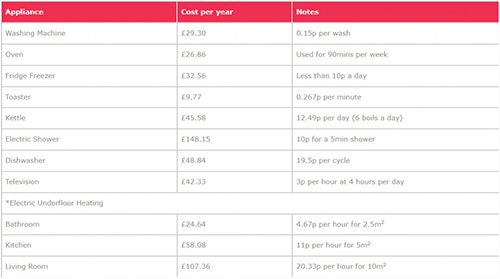7 min read
How thick is underfloor heating?
When looking into installing underfloor heating, ‘how thick is underfloor heating?’ ranks in the top three of the most common questions asked. There...

Is underfloor heating expensive to run? – This is probably the single question that I get asked the most by folks who are looking to purchase electric underfloor heating. In fact, over 5,000 people came to us directly in 2021 to ask about the cost of their electric underfloor heating.
So we get it, cost matters. There is the cost of purchase and installation, but increasingly more important is the cost of running. Firstly for budgeting household expenditure whilst you are living in your house, but also an efficient and cost-effective heating system will add value to your home should you wish to move.
And to answer the question ‘is underfloor heating expensive to run’ is difficult, because as with so many appliances in a house, there are a lot of variables.
So, I’ll do my level-best to show you the factors that drive running costs up and what factors drive the running costs down.
Then I’ll show a short calculator to make it specific to your project, followed by a story about coffee.
Yeah, I know. But it will make sense when we get there 😊
Firstly, we need to understand what factors can drive the costs of running underfloor heating up. There are two considerations – time and insulation.
As you would expect, the longer you have the underfloor heating on for, the more it will cost to run. No surprises, right?
But there’s more to it than that – we’re not asking you to compromise on comfort by only having your underfloor heating on when you’ve got the Queen coming to stay, and living in 14 jumpers, slippers and a handful of hot water bottles the rest of the time.
Unlike other heating sources, electric underfloor heating gets to the desired comfort temperature very fast – often within 20-30mins. However, there is a misconception that people must have their heating switched on for 1hr30mins before needing to use the room… it used to be the case for some central heating, but not for electric underfloor heating.
Nowadays, many thermostats, thanks to LOT20, have an ‘Adaptive Start’ function where the thermostat learns how long the electric underfloor heating system needs to heat up, and then sets the exact right length of ‘heat-up time’ accordingly. This can often save 3 hours of running time in an average domestic property. Clever huh?!
We always recommend insulation board underneath the underfloor heating to make it effective.
“Oh yeah right” I hear you say, “That’s just an upsell tactic”.
No seriously… it’s all about Physics.
“Oh Physics, like the fact that heat rises?”
But actually, heat doesn’t rise… hot air rises, but in a solid build up (like your floor substrate) heat will move pretty much evenly up and down. Here’s the techy explanation.
Which means that if you put electric underfloor heating straight onto a 100mm screed, with tiles on the top, you will heat the tile floor finish at the same rate as you heat the screed substrate.
I thought we were talking about running costs?
We are…
If you are heating the substrate and the floor finish, you could be doubling the time that you have your electric underfloor heating switched on, which will cost you twice as much.
Based on scientific tests and experience, a 10mm insulation board creates sufficient enough ‘resistance’ to send the majority of the heat upwards, potentially halving your running costs.
Some people say that they don’t have the height build-up available to fit 10mm insulation in. That’s fair enough, in a renovation, space can get pretty tight. So to help out with that, there are 6mm boards available on the market which are better than nothing.
Most electric underfloor heating companies have two different insulation board options – one for concrete substrates, and one for timber substrates.
Have a think about how you can maximise and reduce running costs the efficiency by including insulation board into your project.
There is a simple calculation that you can use to work out how much the underfloor heating will cost in your room.
Or head over to our running cost calculator to avoid the maths and get the same result 😊
So, let’s take an example:
1.8p x 3 x 4 = 21p /day
= £1.51/week
Which is about the price of the average cup of caramel latte from Costa or Starbucks per fortnight.
There’s the coffee story. Thanks for hanging in there with me 😊

As far as running costs go, location matters, brand doesn’t.
With regards to location, the price you pay per kWh for electricity will have a direct correlation to the running costs of your electric underfloor heating. Head over to this map to see the difference it can make.
Different brands of electric underfloor heating don’t really affect running costs – that is, if the output per square metre is the same.
But remember, the main driver to running costs will be the thermostat programme and the amount of insulation of the floor build up (and within your home).
In short, not really. If you are moving a floor temperature from 16oC to 21oC, it will use the same amount of electrical energy to do so, regardless of what system you choose. This is because electric heating is 100% efficient at point of use.
The speed that the floor will reach the desired temperature will change (this is governed by the output per square metre of the system) but the running costs will stay the same. Or in other words, the output per square metre affects the length of time that the energy is used, not the amount of energy used.
Here’s an example…
If a 3m2 bathroom with a 150w/m2 UFH system takes 30 mins to heat up, it will use 225w to get to temperature.
If the same bathroom is installed with 200w/m2, it will still use only 225W to get to temperature, but will do so in 22mins instead.
This doesn’t affect the running costs, because the same amount of energy is used. However, one thing that your electrician should bear in mind is that a higher output per square metre will use more electrical load (measured in amps) which may affect the wiring needed.
ELECTRIC UNDERFLOOR HEATING COST CALCULATOR
When looking at electrical appliances, its fairly straight forward to compare. Have a look at some of the options below for some comparisons!

*Remember that electric heating system will replace your traditional central heating system so that you won’t be doubling heating costs.
Like I mentioned at the start, there are many variables that must be taken into consideration when asking whether electric underfloor heating is expensive to run. There are a few things you can do to ensure the cost is kept to a minimum, like installing insulation board and programming the thermostat correctly. If you’re unable to do these things and are still looking for the cheapest way of heating your house, electric underfloor heating is probably not for you.
Hopefully this blog has helped in answering some of the questions you have. We at ThermoSphere are specialists in all things electric underfloor heating, so get asked these questions all the time. If you have any further comments, or would like clarity about your own specific requirements, we’d love to hear from you.
Until then, ciao for now!

7 min read
When looking into installing underfloor heating, ‘how thick is underfloor heating?’ ranks in the top three of the most common questions asked. There...

5 min read
When you think of underfloor heating, the first thing that most likely comes to mind is heating a tiled floor in a bathroom or wet room. However,...

5 min read
This is one of the most commonly asked questions and for good reason! With so many brands of underfloor heating out there including Warm Up, Heat Mat...